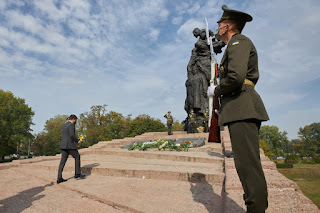September 29, 2020 (Ukrinform) Today, Ukraine marks the Day of Remembrance of the Victims of Babyn Yar, one of the most horrific symbols of the Holocaust. The first massacre of the unarmed civilian population was conducted by the military in the Nazi-occupied Kyiv on September 29-30, 1941. From September 29 to October 11, 1941, the SS forces killed almost all Jews residing in the city - over 50,000 men, women, and children. Almost 34,000 people were killed in the first two days. On October 1, 2, 8, and 11, Nazi troops shot dead those who did not appear on orders - about 17,000 people more. The motive for the massacre was a blatant lie about the participation of Jews in mining and explosions in Khreshchatyk Street, which resulted in killing many Wehrmacht soldiers and officers. Babyn Yar, the large ravine on the northern edge of Kyiv, was chosen as a place for mass shootings. It was two and a half kilometers in length and in some places reached a 50-meter depth. At the end of the street, a gate was built, which people were allowed to enter in groups of 30-40 persons. Previously, they had been forced to undress and give up personal belongings. Then they were machine-gunned into the ravine, which was immediately covered over, with some of the victims still alive.
According to various estimates, from 100 to 150 thousand people were killed in the Babyn Yar during World War II: Jews, Roma, Karaites, Soviet prisoners of war, members of the Ukrainian national resistance movement, patients of psychiatric clinic and representatives of other national or social groups. The shootings in the Babyn Yar continued until Kyiv was liberated from the invaders in 1943. In Soviet times, the terrible tragedy was mainly silenced. Writers Viktor Nekrasov, Anatoliy Kuznetsov, and dissident Ivan Dziuba were among the first to raise the taboo topic. Along with Auschwitz, Babyn Yar became a horrific symbol of the Holocaust in Eastern Europe and an example of what misanthropic theories lead to. The Babyn Yar tragedy is commemorated at the state level in Ukraine.
President of Ukraine Volodymyr Zelensky honored the memory of the Babyn Yar tragedy victims on the day of the 79th anniversary of the mass execution of civilians by the Nazis in Kyiv.













